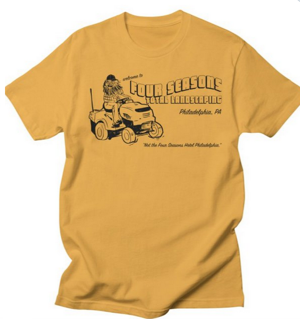A longer than usual drive made tolerable by recorded books.
– The Drive South
– Life at the Backwaters Camp
– Drone Footage of Our Backwaters Camp
– A Visit to Slab City
As usual, I went south for the winter this year. And as of this week, I’ve already been away from home for a full month. I thought I’d write a few blog posts to catch you up on this year’s trip, starting with the drive south.
My Departure: Early on the Calendar, Late on the Clock
I left earlier than usual this year: Sunday, November 15. Earlier in the month, I’d made the decision to go — I’d been on the fence about it for months — and as the days got ever shorter I found myself eager to go. We’d already had some snow at home and I dreaded the thought of dealing with more on my trip. I was driving with my truck, truck camper, and 12-foot cargo trailer outfitted as a jewelry studio and had no desire to deal with slippery road conditions along the way.
The goal was to get deep into Oregon on that first day, but I had too much last-minute packing to do. By the time my rigs were packed, the camper was on the truck, and the trailer was hooked up, it was after 2 PM. Since I prefer not to drive in the dark these days, I knew I wouldn’t get far. I considered waiting until the next morning to depart, but my house-sitter was already installed and did not relish sleeping on the sofa while he slept in my bed. So I loaded up my pups, turned on the heated seat, and headed out.
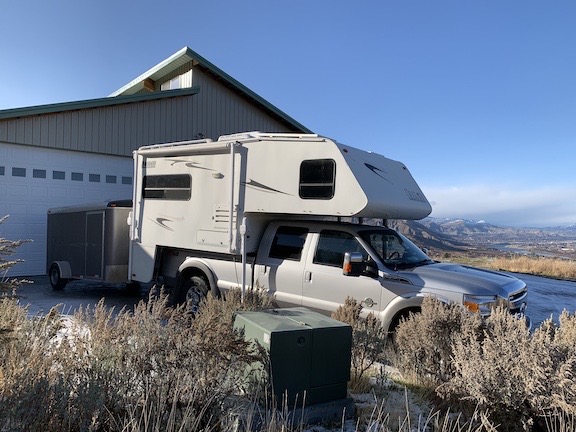
I snapped this photo before leaving on Sunday afternoon. My house sitter was watching from the deck, which is hidden from view in this shot.
I needed 4WD to get out of my driveway. There was just enough ice at the top of the little hill there to almost send me sliding backwards.
Although I’d skipped lunch and was really hungry, I didn’t stop until we reached my first overnight spot: Marysville State Park on the Columbia River at Route 97. Regular readers of my blog know that this is one of my preferred stops for winter driving with the camper. It’s cheap, there are pull-through spots, and the power is turned on (although not the water) at campsites. It was full dark when I arrived after 6 PM and I nearly missed the turn. I pulled in and slipped into a nice spot along the river. After a quick dinner of reheated leftovers, I took the girls for a walk through the fallen leaves to get a registration envelope. I’d pay on the way out.
You might be wondering why I was taking a route that would bring me through central Oregon rather that the much fast route through Idaho and down through Nevada. Two things. First, I had hopes of visiting a friend in the Sacramento area who is moving to Texas in the spring. Second, I wanted to visit a business where I was considering trying to get a job — remote, of course — in south central California. Route 97, which I’d taken many time when I worked in Central California in the spring, was not only a good direct route to both places, but it avoided the high elevation areas where it would be super cold and possibly snowy. I’ve had to stop for fuel in Jackpot, NV when it was -19°F and it wasn’t fun. Neither is dealing with frozen pipes in a camper.
Day 2: Oregon into California
We left just after dawn on Monday morning. I made one stop on the way out to pay the overnight fee and to use the central “winter water” spigot to top off my fresh water tanks.
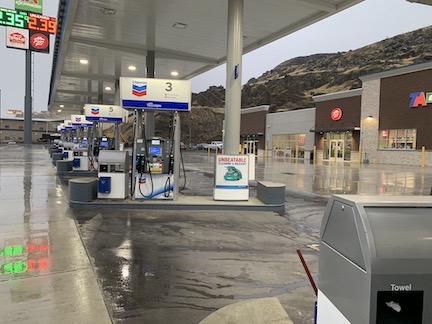
This gas station looked brand new but wasn’t very busy at 7:30 AM.
Across the river, in Biggs Junction, I fueled up at what I think was a brand new fuel station. Fuel was much cheaper there than in Washington. I grabbed a McDonald’s breakfast at that truck stop town and got back on Route 97 south.
It rained.
There was fog.
The road was mostly empty, as it usually is, getting busy only by big towns like Redmond and Bend. I made a stop in a shopping center parking lot with some grassy islands and took my pups for a quick walk. Then back on the road.
The drive would have been boring if I wasn’t listening to an audiobook. I was working my way though Stephen King’s Dark Tower series, which I had been getting as audio books from the library. There’s nothing that makes a drive go faster than having something good to listen to. These books took a turn for the weird — even by King’s standards — in volume 5 or 6 but I did listen to them all by the time I got into Arizona.
I stopped for fuel just north of Klamath Falls. My pups walked a bit on a leash but didn’t do any business. I got back on the road. I figured I’d stop at a rest area I knew farther up where I could let them run off-leash. But when I asked about it at the agricultural inspection stop at the California border, they told me that rest area was closed. (And, fortunately, they didn’t take the 40-pounds of Honeycrisp apples I’d bought in Wenatchee to eat and give as gifts to friends.)
I passed a closed Forest Service Ranger Station with a big empty parking lot bordering on empty land and made a U-turn to go back to it. I let the girls have a run and do their business. I cut up one of those apples for a snack. We got back into the truck and continued on our way.
We eventually drove through Weed, CA and got onto the I-5 freeway. We’d been getting great views of Mt. Shasta for miles and miles and remembered a view area along the way. I found one — probably not the one I was thinking of, though — and pulled off, despite the NO RVS sign. It was empty. I parked where I could easily turn around and got out with the girls. On the way to the interpretive sign, I found traces of party gear: hypodermic needles, empty beer cans, and broken liquor bottles. We didn’t stay long.

My girls had plenty to sniff when we stopped at the lookout area for Mt. Shasta.
It was around 4 PM in the Redding, CA area that I decided I’d better find a place to stay. I’d covered more miles than I expected to, but not nearly as many as I needed to reach the possible overnight destination near Woodland I’d been thinking of. I saw a sign for a casino and got off the freeway. Casinos often allow free overnight RV parking and they have the added bonus of good security.
This casino had overnight parking, but it wasn’t free. Part of their lot had been set up with drive-through RV spaces, each equipped with water, power, and sewer hookups. The fee was $30 — not much more than I’d paid the night before for power only. There was an exercise trail, a golf cart shuttle to the casino (which had a restaurant), and good security I decided to stay.
I had to go into the casino to register and pay. That was an odd experience. Inside the door, I had to stop and stand at a sort of test station. An automatic system took my temperature while I pulled off my mask and got my picture taken. Inside, the place was packed and rules said you didn’t have to wear a mask if you were sitting down. All the slots were filled with unmasked people, half of whom were smoking. I made a bee-line to the registration desk and paid up, eager to be out of there. Even my idea of getting a meal to go from the restaurant evaporated. I wanted out.
That evening, after walking the dogs, I heard some guy walking around the parking area loudly calling out a woman’s name. When it didn’t stop after 20 minutes, I called the casino front desk and told them what was going on and that I was a little freaked out. (Honestly, I wasn’t frightened but it was annoying.) In less than 5 minutes, security arrived and the shouting guy was gone.
I took advantage of the hookups to use my microwave, wash all accumulated dishes, take a shower, and then dump both tanks before departing in the morning. My pups and I also took advantage of a nice trail that wound through the woods around the property, including down by a stream that feeds the Sacramento River.
Then it was back on the road.
Day 3: California All Day
By this time, my Sacramento friend had cancelled. She was feeling under the weather and at high risk for COVID. Although I’d suggested we get food to go somewhere and eat outdoors, she just wasn’t feeling up to it. That was fine. I had a lot of miles to cover anyway.
I’d originally considered stopping at an Apple store to buy a new iPad — mine has definitely seen better days — and a Trader Joe’s to stock up on some staples I wanted over the winter, but I decided against both things. I was planning to go to the Phoenix area over the weekend and could do both then. Instead, I just got on I-5 and headed south.
I tried to stop for fuel and a bite to eat in Woodland but couldn’t seem to find an easy-access fuel station that sold diesel. So I continued through the Sacramento area as my truck’s computer ticked down the miles until empty. I think I was on 12 when I finally found a truck stop in Lodi, CA. I fueled up, parked away from the pumps, and went inside to use the bathroom and get something to eat. I was on line at a Subway inside the truck stop when I realized that the food prep person wasn’t wearing a mask. I wound up getting lunch at another fast food place across the road.
I need to make it clear here that I really don’t like fast food and normally don’t eat it. But when you’re on the road, eager to put miles behind you, you take whatever you can get that’s quick and easy. So I ate a lot of crap on my trip south.
I continued down I-5 through California’s Central Valley. The freeway was in rough condition in some places — it’s such a shame we can’t take care of our infrastructure — and there was mostly farmland on both sides. Boring. I don’t like freeway driving, but it is usually the fastest way to travel. And by that time, I just wanted to be there.
But I did have one more stop: that business I mentioned earlier. I don’t want to go into details here. I’ll just say that I needed to visit the factory for a company I thought was up-and-coming based on information I’d gotten from an insider. I was hoping for a job doing communications work, including making videos of their products in production and use. I was thinking that a salaried job that paid me for getting work done (instead of punching a clock) and included benefits like a healthcare plan would be a good thing to transition into over time.
All that changed when I arrived at the factory. It wasn’t at all what I expected. And as the manager gave me a tour of the place and I realized how far behind they were in production, any thoughts I had of joining the team vanished. There was no place for me there. I wondered about my insider friend and how he could possibly believe the overly optimistic things he’d told me.
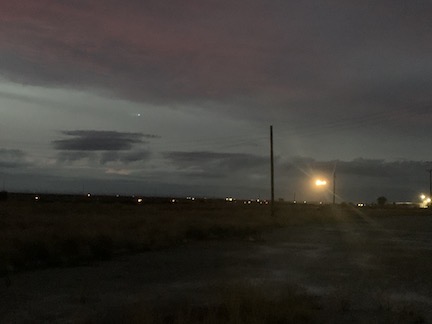
Crop-dusters in southern California fly after dark. This plane had FOUR headlights.
Anyway, I got permission to camp in the parking lot overnight, so I did. It was in a weird industrial place near an airport. I got to watch a crop-duster come and go until long after sunset. Otherwise, it was pretty quiet. I slept well and as soon as the manager opened the gate and came into work, I pulled out of the lot and continued my drive.
Day 4: Arizona, Finally!
It rained on me as I drove east along the farm roads to Route 99. I was planning on crossing the mountains at Tehachapi, not wanting to deal with the Freeway traffic of southern California. The rain stopped before I’d reach the pass. I stopped for gas and a pee at an absolutely disgusting gas station in Tehachapi before getting back on the road. GoogleMaps took me on a detour I don’t think I needed to take, then dumped me in a desert city, putting me on roads with traffic lights and suburban stop-and-go traffic. After a half hour of that, I left the traffic behind me and headed east on Pearblossom Highway. Eventually, I hit I-15 and took that to I-10. We continued through the Palm Springs area and climbed up from sea level toward Arizona.
It had been a long time since I’d driven on most of those roads and I don’t think I would have chosen them myself. But I was so disillusioned about my factory visit the day before that all I could think about was ending the drive and starting my winter vacation. I was tired of driving. I just wanted to be there already. So I let GoogleMaps pick the route and went with it. Other than the unnecessary detour, it was pretty direct.
I was down to 60 miles left on my truck’s computer when I crossed the Colorado River on I-10 and took Exit 1. I had two different campsites in mind: the one we’d occupied the year before and another one about 5 miles south. Timing was everything, I knew, and I’d take the first one I found open. That was the one we’d been in the year before. I backed the trailer in, unhooked it, and repositioned my truck for the night, relieved to be done driving.
The Campsite
I didn’t drop the camper off the truck. Why? Well, my friend Janet would be joining me for part of my stay and she didn’t want to camp in that site. There wasn’t enough sun for her; although my solar panels are on my camper’s roof, she uses a portable solar panel that she puts on the ground. That site is surrounded by tall reeds so the sun doesn’t hit her panel until after 9 AM. She had no interest in putting her panel on her camper’s roof, even though that had worked for her the previous year.
The site I was parked on was one of a pair separated from each other by a boat ramp. Friends of ours had occupied that site the previous year. The other spot was larger and a bit sunnier. But it was also occupied. I figured I could keep the camper on the truck and slip into the other spot when the folks in it left.
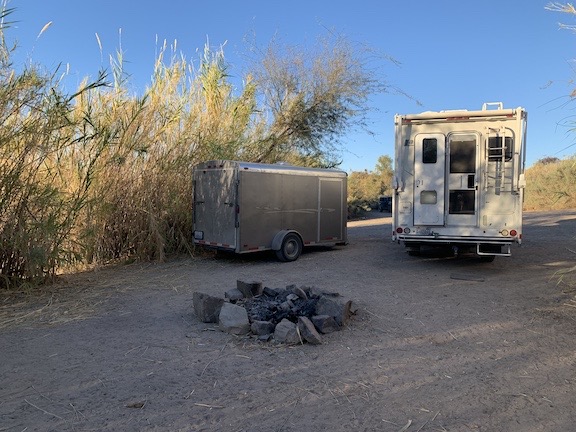
Here I am after landing at the first campsite and finally disconnecting the trailer. I was glad to be done driving.
But, at the same time, I’d just driven 1,300 miles in four days, much of it through rain, and I wasn’t interested in searching for another campsite. So I spent the night there, with my camper still atop my rig.
In the morning, I felt rested and ready to stock up on a few supplies. I didn’t mind driving with the camper on my truck — hell, I’d just spent the past four days doing it. But, at the same time, I wondered whether the other site I’d been interested was available and, if so, what kind of condition it was in. The area was heavily used during the summer and some of the sites accumulated a lot of trash. It wasn’t uncommon for us to spend a bunch of time cleaning up after others when we camped. The site I was interested in had had a car wreck in the middle of it the last time I’d visited. I could only imagine what else was there.
But I didn’t need to imagine. I got into my truck and, leaving the trailer behind to hold the campsite for me, headed south on the gravel road.
Most of the campsites along the way were occupied and looked as if they had been for some time. One site along the road was available, but I knew how dusty it could get. I drove for miles along the river. The road was in dismal condition, with washboarding and potholes. I bounced along at 20 miles per hour, wondering how much cleaning up I’d have to do in my camper when I parked. Finally, I reached the turn for the site I liked. I peeked down its road before turning in. Nothing. I turned and drove to the end.
It was empty. It was even clean. Even the wrecked car had been moved.
I called Janet and asked if that site would work for her, knowing it would. It was a lot sunnier. Like the other site, it had a boat ramp that led down to a backwater channel where we could paddle our boats and fish. This channel didn’t exit to the river — it was fed from culvert pipes that ran between it and the river and another channel — but it was about a mile long. I’d camped there in the past with her once and I think she’d camped there several times.
She gave me the green light. I chose a spot for my camper and backed in. 15 minutes later, it was parked on its legs in a level spot and my truck was free of its burden.
I drove back up the road to fetch my trailer and parked it a short distance away in the new campsite. Then, making sure everything was locked up, I drove back up the road and into Blythe for some groceries.
I got back to my new camp just after 2 PM and spent the rest of the day setting up camp. It was great to be done driving.
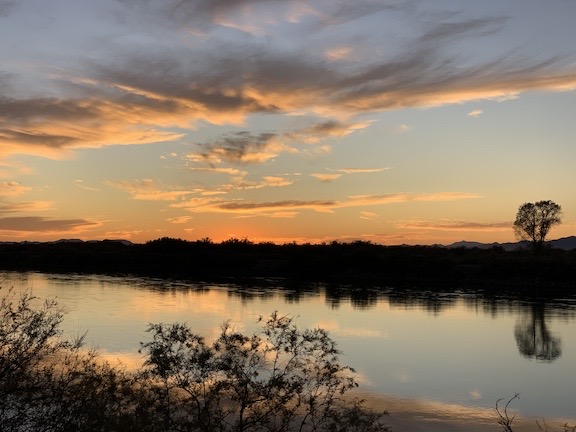
The view of sunset across the Colorado River from the main road a few hundred yards from camp. Arizona has been treating us to quite a few magnificent sunrises and sunsets since we’ve been here.
Janet would join me with her rigs four days later.


